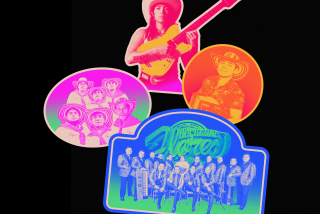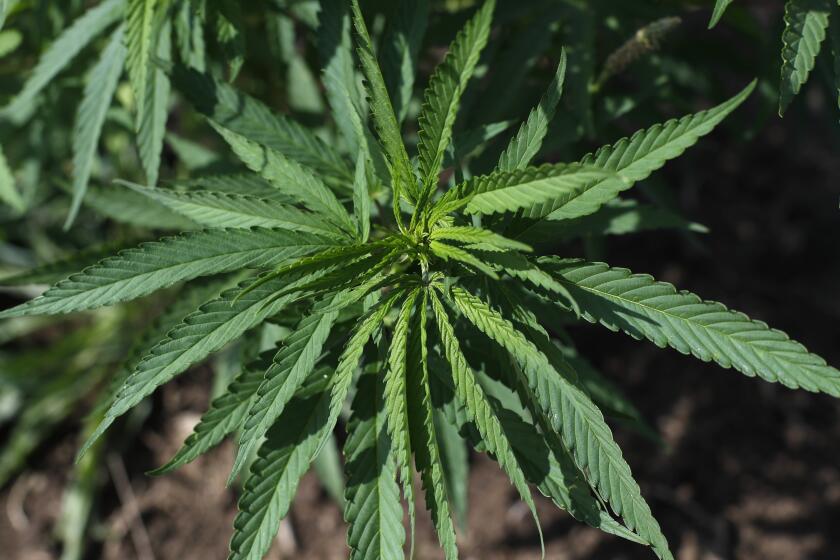Drummer Hopes His Efforts Reverberate in L. A.
One winter’s night 30 years ago, Hal Noble Ector, a young man wanted by the police for marijuana possession, stole a friend’s conga drum and slipped quietly out of South-Central Los Angeles. That drum both began his exile and gave him a life.
Ector’s exile from Los Angeles would take him many places--San Francisco, Guadalajara, Port-au-Prince and New York--but he clung to his drum and kept playing.
Eventually, he became good enough to sit in with such jazz greats as Joe Henderson and Archie Shepp, good enough to dream of becoming a master conguerro, good enough to earn the nom de guerre “Taumbu,” Creole for drum.
Two years ago, beckoned by the bounty of good jazz musicians, Taumbu ended his exile (a largely self-imposed one since the charges were dropped in the 1970s) and returned to Los Angeles. He settled in the Crenshaw district--just in time to watch the city burn, and to see blacks and browns fighting in the streets outside his home.
For Taumbu, an African American who plays African-based music mainly listened to by Latinos, the conflict made him envision ways the two cultures might be reunited. And so again, he turned to the instrument that sustained him during his years on the road and in prison, seeing in the drum the basis for rapprochement between blacks and Latinos.
“ This is our link,” says Taumbu, 50, dealing out a quick riff on the conga. “This is our common ground.”
Taumbu’s homecoming has been a mostly encouraging one so far. His self-released CD of Afro-Cuban jazz and world music has sold 3,000 copies; it has gotten good reviews, and it is being heard on the radio locally and nationwide. Musicians and celebrities such as Ruben Blades, Wesley Snipes and the legendary Cuban bassist Cachao are showing up in the audience or on the bandstand jamming with Taumbu’s 10-member ensemble.
*
Equally important work is happening in Taumbu’s cavernous studio on 54th Street near Crenshaw Boulevard, a primarily black neighborhood with an increasing number of Latinos. Inside the two-story space, which also serves as the rehearsal site for the Taumbu International Ensemble, artwork done by friends and neighbors hangs on the walls. A potpourri of African instruments, such as berimboas, shekeres and congas, many of them made by Taumbu, are scattered throughout.
It is here, in a former hangout for crack users located next to the Kabaza Art and Drum Gallery and across from the Institute of Musical Art, that Taumbu, his Mexican-born wife and others are taking a bicultural stand.
In February, to coincide with Black History Month, the studio will debut as a gallery, displaying the works of two local artists and auctioning off one of the paintings for charity. Eventually, Taumbu says, he would like to hold classes in conga playing and instrument making for the community, as well as turn it into a venue for live music and poetry.
The hope is that once blacks and Latinos put aside their differences inside the center, bridges might be built between two cultures that, as Taumbu sees it, “had forgotten all they had in common,” their mutual interests destroyed by years of suspicion, neglect and common poverty.
That the area is a stone’s throw from the burgeoning arts mecca in Leimert Park also figures into the plans.
“I’m going to make this a focal point for the community,” Taumbu said. “This is the beginning of a renaissance in our neighborhood.”
It has been a long time since Taumbu stayed in any one neighborhood long enough to claim it as his own. The often-hardscrabble life of a musician, coupled with his natural inclination to wander, led him to crisscross the United States, Mexico and the Caribbean for years and landed him for a while in a Mexican prison on what he says was a trumped-up weapons charge.
In 1980, while on tour in Jalapa, Mexico, Taumbu met his future wife, Felicidad Gongora, who sings and plays percussion in the ensemble. It was with her help, he says, that he finally made a full-length record of his music and returned to Los Angeles with a greater sense of purpose than when he left long ago.
“We got the gallery, we got potential, we got enthusiasm,” Taumbu said. “We got an atmosphere going here.”
*
These are not, Taumbu acknowledges, the best of times to float the idea of cultural detente. Resentment is hardening among the city’s Latinos and blacks, as illustrated by the voter breakdown on Proposition 187. While most Latinos saw the anti-illegal immigration measure as a direct slur on their presence in the state, nearly half of the city’s African Americans voted for it.
“African Americans are being brainwashed by the media and the media’s scare tactics that they’re going to lose out,” Taumbu said.
To Taumbu, the two cultures’ musical bond long predates the current tensions and their once-common struggle in the United States as victims of discrimination. The sound of the conga is the basis for most of popular Latin music, he says, and the list of African American musicians who have recorded Latin-influenced music is a long and distinguished one, from Miles Davis to Dizzy Gillespie to Herbie Hancock. Harlem, Taumbu said, underwent a mambo craze beginning in the 1940s that lasted more than a decade.
“African Americans have always supported Afro-Latin jazz,” Taumbu said. “And any time Latin people listen to salsa, rhumba and the mambo, they are listening to African music.”
It is a starting point, one of many small ones necessary to repair the torn relationship between blacks and Latinos. Although it seems modest, Taumbu insists that nothing is as fundamental, or as primal, as the beat of the drum.
“We have to show a common front,” Taumbu said. “Not only musically, but culturally, politically and economically. Once we find some common ground, we’ll find our needs and interests are exactly the same.”
More to Read
Sign up for Essential California
The most important California stories and recommendations in your inbox every morning.
You may occasionally receive promotional content from the Los Angeles Times.










